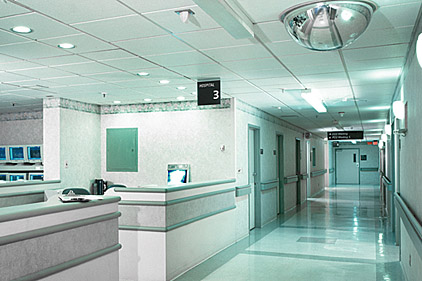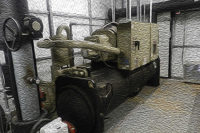What primarily drives dehumidification in hospitals are the individual room requirements for outside air change rates, room exhaust, and pressurization for the purpose of infection control. Nursing and ancillary (mainly laboratories and radiology) inhabit most of the square footage of the hospital and call for two ach of continual outdoor air. Surgical and critical-care rooms can require up to four ach of outside air supply, and airborne infection isolation, emergency waiting, triage, and various rooms in the laboratories and pharmacy will need eight to 15 ach of exhaust. Outdoor air is mandatory to make up the volume of air being removed from these rooms, and additional air must be brought into the building to protect the areas with higher sterility requirements. Hospital codes require air movement to travel from clean to the less clean areas.
In addition to outside air supply requirements, humidity levels within each space must be achieved to meet the required environmental conditions. Spaces such as conference rooms, classrooms, waiting areas, sterile processing, kitchens, and dining rooms generate more latent heat than nursing, diagnostic, treatment, and ancillary rooms mentioned previously. A significant amount of moisture must be removed from the supply air delivered into these latent intensive spaces to meet specified humidity levels. The engineer must calculate the dewpoint of the air entering each space type.
ENERGY SAVINGS CHALLENGES
Regulations for health care facilities are written to deliver the cleanest environment, but they also introduce many challenges for energy savings. The traditional method of simultaneous cooling and heating to maintain humidity is highly wasteful, and new practices are available to achieve the desired humidity level using far less energy. The entire building should be evaluated as a holistic building system, with health care departments and specialty suites strategically separated into categories with common characteristics. We will identify the main categories for the purpose of energy savings in this article as surgical and critical care, principally populated, largely latent, exceedingly exhausted, and superlatively sensible. Most rooms will fall into only one or two categories, while some will share common characteristics. The goals are to use a system or a combination of systems that can decouple the latent from the sensible, only supply the amount of air needed for these departments with these said characteristics, and use energy-recovery devices that utilize exhaust and building relief to remove the sensible and latent load in the incoming outdoor air.
Surgical suites should be on a dedicated system. Because of the stringent requirements for filtration, pressurization, and smoke evacuation for anesthetized patients, variable volume systems provide the greatest reliability. The BAS should set back the system operation during long periods of non-use. Variable volume boxes should reduce to minimum airflow to maintain pressurization for the sterile environment. Discharge air temperature at the AHU should be reset to the highest temperature possible to maintain the humidity space setpoint. This discharge air temperature can be controlled by zone humidity or outside air humidity sensors.
Areas that are principally populated, such as administration departments that house large conference rooms and classrooms, should be separated from other hospital systems. To reduce the amount of energy consumed to dehumidify the outside air needed for people, these systems should incorporate demand control ventilation. Sensors that detect carbon dioxide should control the amount of outdoor air needed for people in the space as prescribed in ASHRAE 62.1. Control sequences should be programmed not only to reduce the outside air quantity but also reduce variable volume boxes to a minimum airflow and reset the discharge air temperature needed to maintain the humidity space setpoint.
Similar methods can be used for largely latent and extremely exhausted areas like sterile processing, kitchen, and laboratories. Laboratory hoods should be turned down to minimum when not in use by employing air valves and VFDs. Kitchen hoods need to be shut off when not in use. The AHUs serving these spaces should be set back to minimum airflow and have discharge temperature reset to save energy. Related techniques can be utilized for sterile processing. Largely latent load areas with large sterilizers and cart wash can be grouped and served with dedicated exhaust systems consisting of air valves and VFDs. When equipment is not operating, exhaust should be reduced to minimum to maintain required negative pressure, and the AHU can be set back.
The greatest opportunity to dehumidify and save energy is in the superlatively sensible areas, especially those where code allows recirculated air. These locations include medical surgical, labor and delivery, postpartum, support spaces, and other nursing and treatment areas. Dedicated outside air units (DOAS) with heat recovery that utilizes another energy-efficient system to handle the sensible loads, is the best solution. Such systems include ground or water source heat pumps, variable refrigerant, or chilled beams. The combinations of these systems decouple the latent and sensible load. The latent and sensible load of the outdoor air will be removed at the heat recovery DOAS, while the sensible-only load will be removed from the individual spaces from the building envelope and process loads. All dehumidification for the hospital will be at the heat recovery DOAS. The function of these systems will be terminal in nature and will be ducted or non-ducted controlled by space sensors.
The geography, type of health care building, availability of utilities, project budget, and size of facility will determine which system should be used. All general exhaust and building relief should be gathered and ducted to the energy recovery DOAS for cooling and dehumidification of incoming outdoor air. Care should be taken to avoid cross contamination in the total energy-recovery wheels. Incoming outdoor air pressure must be designed to be higher than the exhaust system. The energy wheel will be selected with a purge cycle. Where cross contamination is a real concern, only heat pipe coils should be used. The DOAS should be sized for the total heating and cooling loads to avoid hospital shutdown caused by a heat recovery function failure. The DOAS should be sized only to bring in the amount of air needed to satisfy all the outdoor air change and pressurization requirements.
Providing enough outdoor air to satisfy ASHRAE 62.1 for people is not a concern for these types of spaces because of the small population density. Sensible heat ratio is near 90%, so cooling and dehumidifying the air slightly below a 54°F dewpoint will satisfy any high humidity requirement for these spaces. During cooler seasons and lower building cooling load, the unit can be controlled to have the discharge temperature dynamically reset as long as dewpoint temperature is maintained.
Variable refrigerant flow systems (VRF) are efficient when they are zoned with energy recovery terminals. During the winter, zones in the interior space that are dominantly cooling can reject their heat to the energy recovery terminal for heating to the exterior zones. Likewise, in the summer, exterior zones can reject heat to the interior zones. One disadvantage to these systems is the high amount of refrigerant routed above patient care areas, where a refrigerant leak would be a health hazard. Another disadvantage is that VRF fans generally do not supply enough pressure to overcome special filtration and typical runs of secondary ductwork to diffusers.
The natural heating and cooling of the earth offers significant energy efficiency. Geothermal heat pumps (GHP), either ground or lake source, can be advantageous, depending on the climate zone, with proper design achieving as much as 50% EUI. Hotter climates present more of a challenge for GHP.
For example, ground source heat pumps installed in hotter climates can become overheated because of the constant cooling load of the hospital. Lake source heat pumps present an alternative, since water does not retain heat well for long, quickly rejecting it back to the atmosphere. The downside of lake source heat pumps is that there is also no heat stored in the earth to be reclaimed in the winter for heating. Hybrid systems are highly desired for hospitals in case a geothermal field is lost. The combination of a closed-circuit cooling tower and a condensing boiler can supplement or back up the cooling and heating of the system.
GHP indoor units can be architecturally pleasing, because their vertical configuration does not take up much floor space. The fans in these units provide enough pressure for special filtration and secondary duct systems, making this system more favorable than a VRF system. Generally speaking, central pumping systems are preferred over multiple individual pumps for each GHP fan unit.
ACTIVE CHILLED BEAMS
Active chilled beams (ACB) are on the cutting edge of technology for space sensible cooling. Passive chilled beams, for the most part, are excluded because of their inability to re-circulate airflow for air change rates. ACB have high cooling capacity because of the surface area of the units and the convective spread of air it distributes. ACB can be designed only in the places that do not forbid re-circulation. This excludes their use in surgery, trauma, critical care, procedure, and specialty areas in laboratory and pharmacy. However, the spaces that allow recirculation are the superlatively sensible areas that occupy much of the square footage in the hospital. Active chilled beams are best utilized in patient room suites such as medical surgical, labor and delivery, postpartum, antepartum, treatment, and waiting.
When chilled beams are initiated in the conversation of health care design, many worry about the air change rates that are required. ACB are able to satisfy this requirement by room per its induction characteristics. For example, a general patient room requires two ach of outside air and a total of six ach of supply air. For ACB, this can be accomplished by supplying two ach of outdoor air from a DOAS and four ach induced from the patient room upward through the heat exchanger and then supplied back through the beam, totaling a combined six ach.
Generally, four parts of recirculation can be achieved for every one part of primary air. Using this technology, we save four ach per patient room from needing to be dehumidified and then reheated. Some hospitals have floor after floor of 20 to 30 patient rooms per wing. The energy savings from this technique are tremendous. Studies have shown that proper design of these systems can achieve up to 60% EUI. Engineers also have concerns of ACB and their limited ability to provide space heating. Solutions that can alleviate these concerns include radiant heating along the perimeter, a four-pipe chilled beam, terminal box heating of outdoor air supply for each zone, or a combination of these options.
What makes chilled beams more favorable for energy savings over a VRF or GHP system is the lack of moving parts such as fans and pumps, which represent the least efficient parts of mechanical systems. The facility staff also enjoys the lack of noise and maintenance. ACB are fairly easy to clean, and there are no worries of maintaining condensate drain, changing belts, motors, or filters.
Architects find chilled beams advantageous in raised or vaulted ceiling situations because they require only enough space above the ceiling to accommodate outdoor air ductwork and piping. Architects can place these spaces around the perimeter of the building in an aesthetically pleasing way for holistic health care. Working together, the owner, engineer, and architect can achieve vaulted ceilings with high capacity cooling, acoustics, comfort control that eliminates air draft, a healing environment for the patient and significant energy savings.
The only way to achieve these goals is to involve all parties early in design. The owner and design team need to have the entire building in mind to achieve this magnitude of savings. Conducting a charrette for high-performance buildings as stated in the National Renewable Energy Laboratory’s A Handbook for Planning and Conducting Charrettes for High-Performance Projects is absolutely crucial. Prerequisites must be set to obtain goals; a plan must be established, and all parties must be held responsible for their efforts at every stage of the project. Commissioning for all systems including measurement and verification of the design that extends throughout the life of the building is key.
Designing for energy efficiency is a way to be good stewards of our limited natural resources and is the most responsible course of action. In this day and age, it also results in facilities that use less energy and cost less to operate. Could you ask for any more? ES




